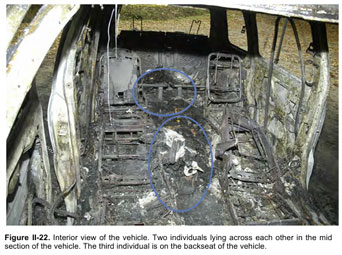Recovery and Interpretation of Burned Human Remains
Steven A. Symes Ph.D.
Dennis C. Dirkmaat Ph.D.
Stephen Ousley Ph.D.
Erin Chapman M.S.
Luis Cabo M.S.
 The new protocols developed from this research demonstrated that a fatal fire scene could be completely excavated, with comprehensive documentation, high evidence detection and recovery rates, as well as minimal evidence alteration, all in a matter of days. The research results show that a complex fire scene can be processed and documented in 2-3 days. The high rate of evidence recovery, as well as the identification of spatial and stratigraphic patterns attained during the mock-scene exercises also showed that these elements could still be detected, identified, and analyzed even after aggressive fire-suppression efforts. Further, the study demonstrated that regular, clear normal patterns of heat alteration of the human body can both be identified and successfully used to detect suspicious cases. Specifically, the agreement between the patterns observed in funerary cremations and those inferred from regular case documentation strongly indicate that efficient and systematic case documentation, analysis, and comparison may be the most promising research approach for improving understanding of heat-related trauma to the human body. In addition, the study shows the high rate of preservation even after calcination of forensically significant tool marks, indicating that it is erroneous to assume that fatal fire scenes can be processed more rapidly than conventional ones, or using substandard recovery protocols under the assumption that most evidence is destroyed. Contrary to popular belief, diagnostic traits indicative of the class characteristics of the tools used to inflict trauma on bone appear to be easier to detect and identify in burned bone. 15 tables, 14 figures, approximately 30 references, and appended data collection and protocol forms.
The new protocols developed from this research demonstrated that a fatal fire scene could be completely excavated, with comprehensive documentation, high evidence detection and recovery rates, as well as minimal evidence alteration, all in a matter of days. The research results show that a complex fire scene can be processed and documented in 2-3 days. The high rate of evidence recovery, as well as the identification of spatial and stratigraphic patterns attained during the mock-scene exercises also showed that these elements could still be detected, identified, and analyzed even after aggressive fire-suppression efforts. Further, the study demonstrated that regular, clear normal patterns of heat alteration of the human body can both be identified and successfully used to detect suspicious cases. Specifically, the agreement between the patterns observed in funerary cremations and those inferred from regular case documentation strongly indicate that efficient and systematic case documentation, analysis, and comparison may be the most promising research approach for improving understanding of heat-related trauma to the human body. In addition, the study shows the high rate of preservation even after calcination of forensically significant tool marks, indicating that it is erroneous to assume that fatal fire scenes can be processed more rapidly than conventional ones, or using substandard recovery protocols under the assumption that most evidence is destroyed. Contrary to popular belief, diagnostic traits indicative of the class characteristics of the tools used to inflict trauma on bone appear to be easier to detect and identify in burned bone. 15 tables, 14 figures, approximately 30 references, and appended data collection and protocol forms.
Abstract
Victim remains at fatal fire scenes are typically difficult to detect, recover and handle. All of the burned material at the scene, including biological tissue, is often modified to a similar appearance, and bones, in particular, become discolored, brittle, and highly fragmented. As a consequence, these remains are often missed, disturbed, altered, or even destroyed during scene processing with the existing protocols.
The added postmortem fracturing, fragmentation and bone loss resulting from these recovery techniques hinder the already difficult task of autopsy and laboratory analysis of burned human remains. This is especially problematic for bone trauma analysis, as its most immediate goal is distinguishing perimortem (forensically significant) trauma, from postmortem (not forensically significant) alteration. The substantial addition of trauma features created by fire and then recovery can result in a daunting analytical task.
Lack of on-scene recordation of relevant information related to body positioning and contextual relationships of remains as well as other physical evidence at the scene, further complicate trauma analysis, biological profile estimation, and event reconstruction. For the trauma analyst, it is arguably difficult to detect and characterize atypical, potentially forensically significant trauma, if the extent of exposure of individual portions of the body to fire is unknown. In addition, very little and often contradictory information regarding what is considered “normal” fire alterations of the human body had been presented. This information lacuna notably included specific burn sequences of soft tissue and patterns of hard tissue modification. The same problem affected estimates as simple and relevant as whether a missing element was ever present at the scene, missed during recovery, or totally consumed by the fire.
The present study addressed these problems by linking rigorous scene recovery and documentation methodologies with subsequent laboratory analyses (in particular, bone trauma analysis) of heat altered human remains from fatal fire scenes. This was accomplished by: 1) developing and testing effective fatal fire scene recovery protocols and guidelines, which have proved to maximize the location, documentation and recovery of biological tissues (including bone), while minimizing postmortem bone alteration and damage due to collection and transport methods, 2) precisely documenting and presenting “normal” soft tissue burn sequences and resulting bone modification in fully fleshed human bodies, burned under controlled (crematorium) conditions and from actual forensic cases and 3) analyzing the macro- and microscopic effects of fire and heat on previously well-described diagnostic characteristics of tool marks in bone, which served to demonstrate that most of these diagnostic traits can be usually preserved, with their full evidentiary value, even after calcination.

